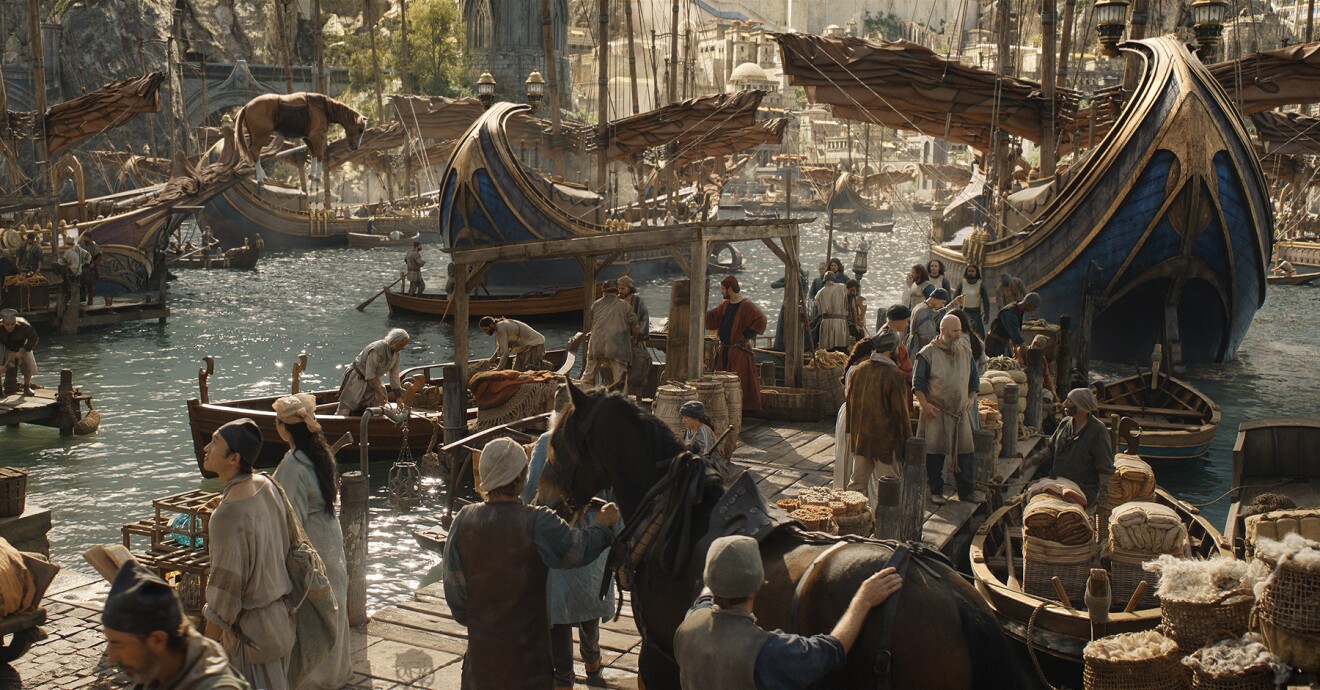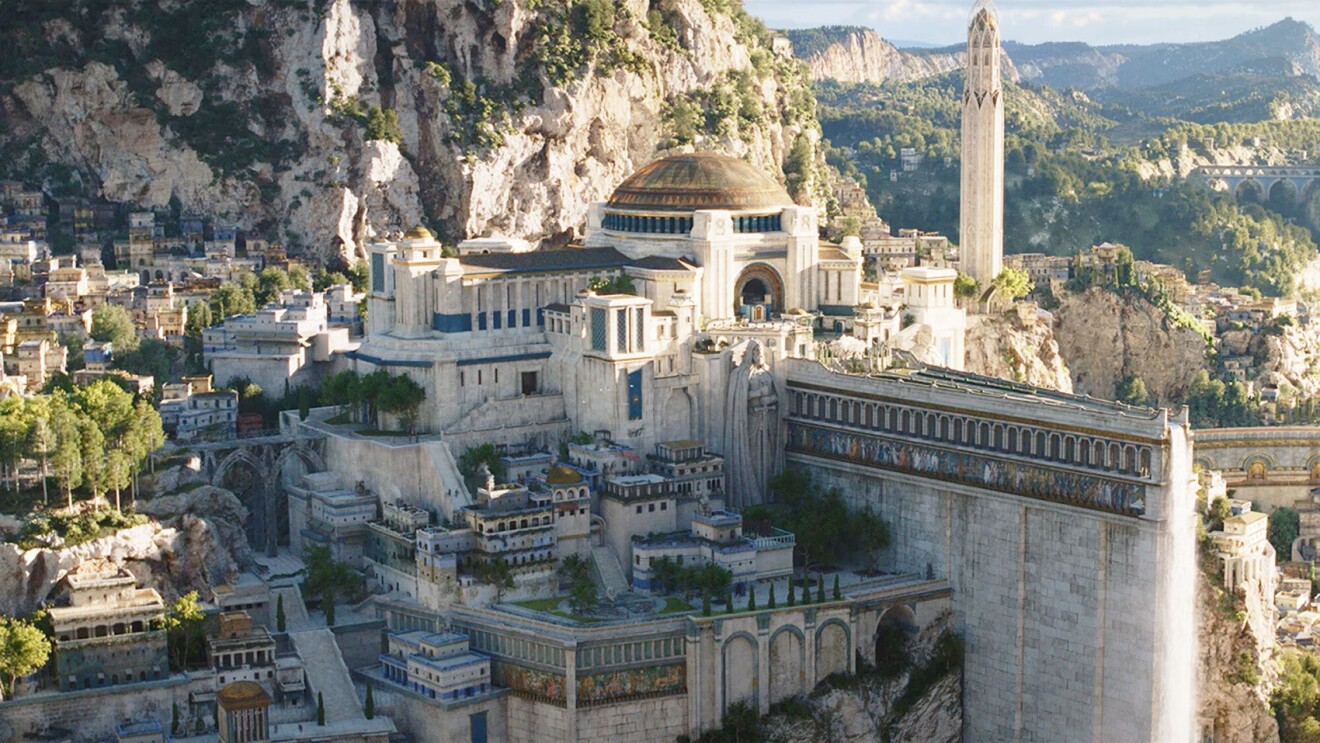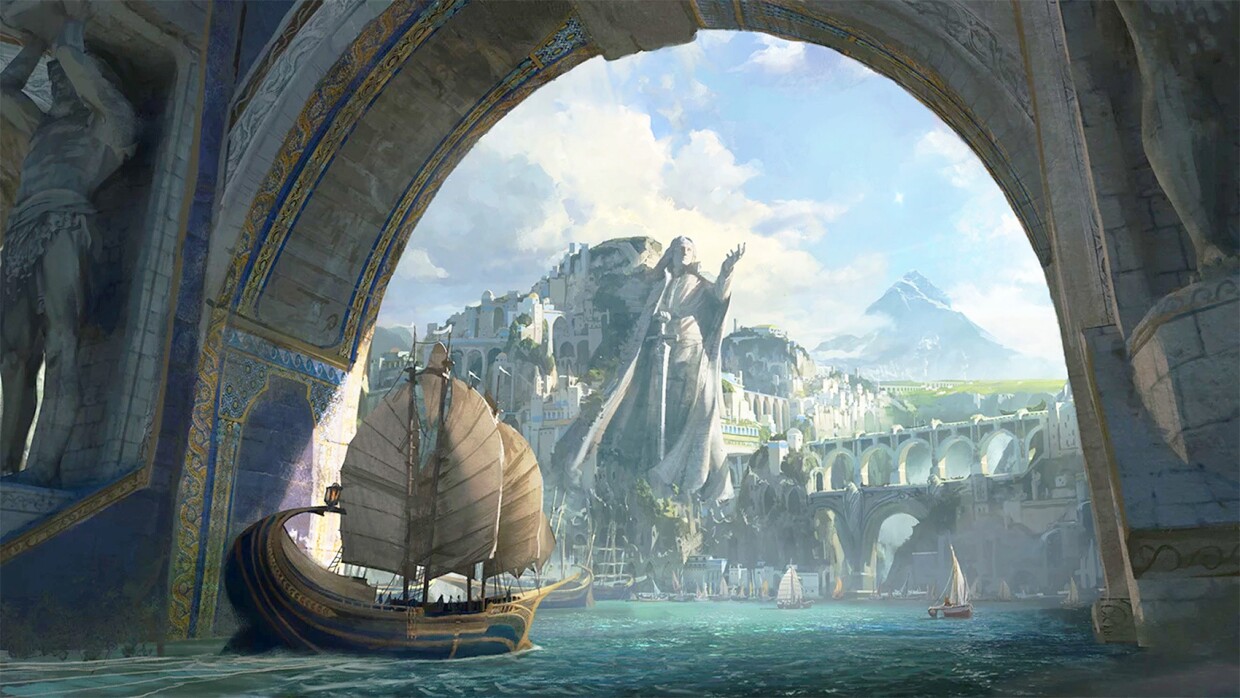How do you bring to life a world that many know but none have seen? This has been a recurring question in the making of The Lord of the Rings: The Rings of Power, set to premiere on Prime Video on September 2. The series takes place in the Second Age of Middle-earth, a time that until now, has only appeared in J. R. R. Tolkien’s writings. That means fans will be getting the first visual representation of a world they’ve only read about, including the island of Númenor, a kingdom that reached its peak—and ultimately, its demise—in the Second Age.
“It’s a civilization that was around for thousands of years and has gone through this whole history of developing,” explained Ramsey Avery, production designer for The Lord of the Rings: The Rings of Power.
Avery, whose resume includes blockbusters like Spider-Man: Homecoming and Guardians of the Galaxy Vol. 2, was tasked with the immense responsibility of bringing Númenor to life on screen for the first time.
“My hope in creating Númenor is to evoke a sense of wonder. A sense of mystery,” he said. “I wanted to create a real sense of ancient history, building up to a current time and place where real people live, work, play, and love.”
Avery sat down with us to analyze three newly released images from the series. Keep reading to take a trip to the Second Age and the island kingdom of Númenor, guided by the man bringing it all to life in The Lord of the Rings: The Rings of Power.
Númenor is a thriving and technologically advanced civilization

Among the newly released images is a scene showing a bustling port in Númenor. “This is a thriving culture,” said Avery. “This shot shows its vitality and how well-off it is.”
There’s a lot to take in, and if you look closely, you’ll find important themes hidden in the imagery. “The horse being hoisted onto a ship at the top left of this image shows two things: One, Númenóreans respect and love their horses; and two, they're a technologically advanced culture,” said Avery. “They figured out these pulley-and-crane systems to be able to maneuver products and goods up and around. That's an important characteristic of the civilization. They've got more advanced technology in some ways than some of the other realms.”
Avery also noted that the bold blue colours on the ships represent the broader aesthetic of Númenor. “We departed from the elegance of the Elven world into a much bolder expression for Númenor,” he said. “We looked to art based in Egypt, North Africa, and the Middle East to inspire the bold shapes, rich colours, and geometrical ornament that are central to the Mediterranean sensibility of this kingdom.”
Númenórean architecture is strong and powerful, yet beautiful

Built high on the cliffside, the Court of Númenor houses the power of the land, Queen-Regent Míriel.
“There is a quote from Tolkien where, on the last high hill, the Númenóreans built their powers,” said Avery. “The court is featured high on the hills among architecture that grows increasingly ‘Mannish’ [influenced by Men] the higher up you get—reflecting the evolution of the culture over time.”
Avery also explained that the structure of the city in the image represents the new politics and complicated history of Númenor.
“There's a much more Elvish structure shown on the far left of the image, and that's the original court built by the Elves 400 years ago,” he said. “The humans of Númenor got to the point where they were done with the Elves' influence, and they built a palace that expresses the strength of men. The structure is powerful, strong, and hulking—it has this real sense of strength and beauty to it.”
Avery also notes that Númóreans’ knack for innovation is depicted again in this image if you look closely.
“The towers on the left and the right feature a cooling system,” he explained. “We looked at a whole system in a Mediterranean or a hot climate, and considered how you would cool the air. We discovered that [buildings in] North African and Middle Eastern countries have these wind catchers where wind gets sucked in, heats up, and then flows out of the tower. As it flows out, it's pooling cool air underneath of it. So throughout the city, you'll see these towers; that's how the Númenóreans discovered how to keep the city cool.”
Númenor is built on water and centered on a vast maritime industry—reminiscent of Venice

While Tolkien’s writings didn’t go into great detail describing Númenor, a single slip of the tongue revealed a thousand words about his vision of the long-lost land. Avery shared that at one point, Tolkien said, “I just got back from Númenor—I mean, Venice.”
“This revealed a sensibility of what he imagined Númenor looked like in real life,” said Avery. “A city like Venice that’s built on water with multiple influences over time.”
Like Venice at its peak, Númenor controls a vast maritime fleet and industry, meaning an important element of its design would be ships that represent the country’s rich culture and aesthetic. The unique shape of the sails was inspired by the ceremonial headwear of the Kings of Gondor.
“We kept trying to find something that said ‘Númenórean’ as opposed to ‘pirate ship,’” said Avery. “The long, triangular sails represented the Elves’ ships, and we needed something that stood on its own for Númenor. One night, I was looking through some pictures and I saw the Crown of Gondor. I'd always thought of that crown as eagle's wings, but I looked at it again and I thought ‘My God, that's a ship’s sail there.'”
Committed to creating a world drawn from reality, Avery shared that he worked with experts to build these unique sails in a way that was actually functional.
“It would be really tricky to sail these ships, but it's doable,” he said. “We talked to rigging experts and they helped us figure out the rigging to make sure it was realistic. Sailors on our set could actually do the rigging to bring the boats to life.”
And true to a civilization surrounded by water, Avery notes that Númenor’s infrastructure was built to facilitate transport through shipping.
“The bridges you see in these images are not just for carts and people,” he said. “Each bridge has a canal, creating a transport system all the way through the city by going through these canals and the locks at the port.”
Númenor is just one magical realm in ‘The Rings of Power’
For Avery, bringing Tolkien’s unseen worlds to life is a childhood fantasy come true.
“I grew up with Tolkien, and this world means so much to me,” he said. “These are environments or ideas that have been an important part of my life since I was 10 years old. To be able to bring them to life, and see the actors and the crew really enjoy it all was a true gift. I’m excited to share this beautiful world and its characters with fans.”
The Lord of the Rings: The Rings of Power premieres on Prime Video on September 2. Stay tuned for more updates.
Artwork courtesy of Prime Video













